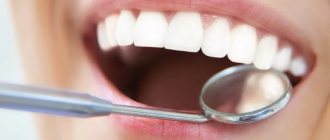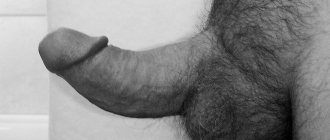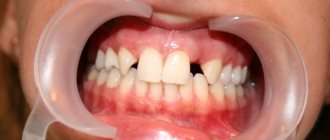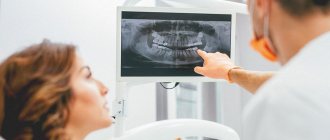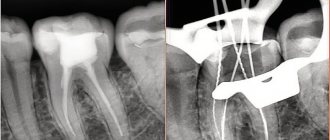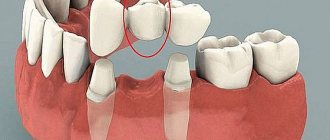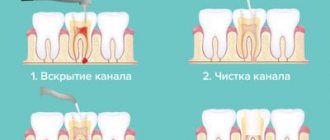At the turn of the 19th and 20th centuries, there was a rapid development of such natural sciences as chemistry, biology and physiology. This process also influenced the transformation of the dental field, which, after being combined with maxillofacial surgery, began to be called the now familiar word “dentistry”.
The main trends in the development of dentistry in the 20th century can be identified:
- The emergence and improvement of specialized areas of dentistry.
- Increasing requirements for the quality of professional training of dentists.
- Rapid improvement of equipment and technologies, creation of innovative equipment, tools and materials, achievement of the highest level of development in practical dentistry.
Already at the beginning of the 20th century, specialized areas were identified in general dentistry, which continue to develop to this day. These include:
Therapeutic dentistry
(research and diagnosis of dental diseases, as well as bone and mucous tissues of the oral cavity, search for treatment methods that maximally preserve the structure and functions of organs and systems).
Surgical dentistry
(research and diagnosis of diseases and defects of organs and tissues of the oral and maxillofacial area, search and improvement of surgical methods for their treatment).
Orthopedic dentistry
(study of violations of the integrity of teeth and jaws, deterioration of their functioning, as well as the search for methods of treatment and prevention of such defects through prosthetics).
Children's dentistry
(study of the process of formation and development of various organs and tissues in the maxillofacial and oral area in children, as well as the search and improvement of methods for diagnosing, treating and preventing various diseases, dental anomalies and defects of the jaws and mucous membranes).
I. Origins
The origins of this story should be sought in ancient times. At that moment, when the first people on the planet first began to have toothache, the development of science began, which at that time was still infinitely far from scientific concepts.
Research confirms that people have been suffering from dental diseases since time immemorial.
- The Cro-Magnons suffered from dental diseases, as evidenced by the found skulls with traces of tooth decay.
- In Slovenia, near Trieste, fragments of the jaw of a man who lived 6.5 thousand years ago were found in our time. His teeth bore traces of wax fillings.
- Egyptian manuscripts (3700 BC) mention dental ailments such as aching teeth and bleeding gums.
- In China 3000 years ago, 9 different dental diseases and corresponding treatment recipes were described.
Ridiculous theories
For centuries, people have tried to explain to themselves the phenomena that they encountered every day. Dental diseases were no exception. In attempts to get to the bottom of the truth, the strangest theories were born, some of which turned out to be surprisingly tenacious. In addition, ancient dentistry was closely connected with religion.
One of the most revered sacred relics in the world is the sacred tooth of Buddha, which is located in the Dalada Maligawa, or Temple of the Tooth, in Sri Lanka. Every year a magnificent festival is held in honor of the sacred tooth. The revered tooth is actually carved from ivory, but there is a fascinating story behind the belief.
Mouse medicine
The Egyptians believed that the mouse was under the direct protection of the sun. In a strange way, this led to the spread of a rather barbaric method of dental treatment: a piece of still warm mouse flesh was applied to a sore tooth, hoping to get rid of the pain.
Patron Saint
Not understanding how to get rid of painful toothache, people resorted to the simplest and most understandable method known to them - they prayed for help from revered saints. One such saint was St. Apollonia of Alexandria (249 AD), who to this day is considered the patron saint of dentists and dentistry.
The Legend of the Toothworm
Belief in toothworms has passed down through the centuries. In Indian texts that are 2000 years old, the following is found: “when there is a lot of food and dirt in the teeth, as punishment, a worm will definitely appear in it and will cause unbearable pain.”
To get rid of worms, quite sophisticated means were proposed - from tobacco dust mixed with water to fumigation with the smoke of burning aloe, myrrh, henbane seeds and leeks. It is not clear how, but this theory lasted for about 4000 years. That is, even in the 19th century, European dentists, already having quite modern treatment technologies at their disposal, sometimes continued to blame elusive worms for dental diseases.
The first dentists of antiquity
The first known dentist is an Egyptian named Hezi-Re (3000 BC) - the chief dentist of the pharaoh himself. It was he who first spoke about the connection between dentistry and medicine.
The ancient Greek physician Aesculapius (1250 BC) was the first to talk about the importance of brushing teeth and proposed methods for removing non-viable teeth.
Hippocrates (500 BC) devoted 32 paragraphs to dentistry in one of his works Peri-Arthron - “On Members”, describing in detail, among other things, the procedure for treating fractures and dislocations of the jaw. One of the texts also mentions tooth extraction forceps.
Aristotle (384 -322 BC), who was a follower of Hippocrates, described in detail the process of removing a tooth with surgical forceps in his book De Partibus Animal Culum (“On the Parts of the Body of Animals”). He also claimed that the cause of tooth decay was the consumption of figs and soft sweets, speaking of tooth decay as a putrefactive rather than an enzymatic process.
He had two wives, but this great expert on the structure and functions of the body believed that men have more teeth than women. Thanks to the unquestioned scientific authority of Aristotle, no one disputed this erroneous statement for one thousand eight hundred years.
15th-17th centuries: from blacksmiths to dentists, from extraction to the first prosthetics
In the mid-15th century, blacksmiths or midwives performed tooth extraction in villages. Wealthier city residents, as before, went to barbers for treatment. But executioners were especially popular. This activity brought them more money than cutting off heads, and pulling out a tooth was much easier, and there was a lot of work. Some even made it their main occupation. In 1700, the official name of the new profession appeared - dentist.
Due to the fact that in most cases teeth were removed, the need for prosthetics increased. But it was only available to the rich.
Precious metals and ivory were used to produce implants. Such prostheses were not very comfortable. Other methods were also found for the villagers - the teeth of the dead and animals were used. But this did not last long, people soon realized that their body was rejecting them.
bridge with donor teeth
denture with animal teeth
In 1684 a big step was taken. Surgeon Cornelius Solingen was the first to use a hand drill. But its widespread use began only in the 18th century.
II. Development
Over the centuries, the development of dentistry has not always moved towards rationalism and progress. There were also periods of calm, and sometimes periods when, despite all accumulated knowledge, dentistry again turned to its barbaric origins.
Rational contribution of different peoples to the development of dentistry
Egyptians
It was in Egypt that the first evidence of surgery on the lower jaw, performed to drain pus from an abscessed tooth, was found around 2700 BC. The Egyptians also practiced splinting teeth, using heavy gold wire to construct unique dentures.
Chinese
Dentistry in China has a rich history. From early times, arsenic was used to treat carious teeth, and in the 2nd century AD. fillings made from a mixture of silver and mercury were first tested. It was only more than 1000 years later that this technology began to be used in the West.
Traveling through China in the 1270s, Marco Polo noticed that men and women constantly wore thin gold plates on their teeth, perfectly adapted to the shape of their teeth. History is silent about whether these were analogues of modern veneers, or whether the plates were somehow supposed to relieve toothache.
In the 11th century, Chinese scientists Ting To Tung and Yu-Shu fully described the process of chewing and swallowing, believing that food was digested by vapors that rose from the spleen.
Surgery was also well developed in China. Ancient monographs describe, for example, surgical restoration of the cleft palate, and this is the earliest mention of this operation in the world. It is known that the Chinese treated dental diseases with a knife, cauterization, and acupuncture.
Greeks
Dentistry in Greece is closely connected with the works of Aesculapius, Hippocrates and Aristotle, who first described some principles of the structure of the jaw and treatment methods, as well as the possibilities of dental surgery. Ancient Greek healers used the pain-relieving properties of henbane. Hippocrates treated toothache caused by inflammation of the nerve using a hot iron.
Hippocrates owns the term “baby teeth” that is still used today. He believed that infants' teeth originate in the uterus and then, after the birth of the child, grow, feeding on mother's milk.
Etruscans
The Etruscans, who lived in the hills of Central Italy, made the most significant contribution to the development of therapeutic dentistry, offering various options for prosthetics and dental restoration. Particularly unique is the example of a bridge created in 2500 BC: the prosthesis is made up of several gold plates that are attached to real teeth and support three artificial teeth.
Romans
The Roman physician Celsus (25 BC - 50 AD) described the removal of severely damaged lower teeth, and also recommended filling the resulting cavity with lead before removal, in order to reduce the risk of crown cracking. He also wrote the world's first description of a technique for positioning and straightening teeth.
Arcigenus (100 AD) was able to diagnose pulpitis and invented a bur to open the pulp chamber.
In general, the Romans did not have any special talents in the field of dentistry and borrowed techniques mainly from the Greeks and Etruscans.
Along with truly scientific treatment methods based on correct knowledge, dental treatment with magical spells and other exotic methods was widely practiced in Rome.
Even the greatest naturalist, Pliny the Elder, described two such methods. The first was that in the light of the full moon you need to find a frog, open its mouth, spit in it and say: “Frog, come and take my pain for yourself!” The second, even stranger method (the effectiveness of which he, however, did not vouch for) was to bite the head of a live mouse twice a month.
Jews
Despite the fact that the Jews left behind numerous written documents, dentistry is mentioned little in them, and dental treatment mainly comes down to the use of rather primitive folk remedies and is largely associated with superstitions.
The doorway - the mouth - must be kept thoroughly clean to protect everything that comes inside from contamination.
In ancient times, it was extremely undesirable for Jews to lose a tooth, and dentists of that time did everything possible to save even a very sick tooth.
The Old Testament (Exodus 21:26-27) provides punishment for a person who loses a tooth: “If a man strikes his servant in the eye, or his maidservant in the eye, and hurts it, he shall let them go free for the eye; and if he knocks out a tooth of his manservant or his maidservant, let him set him free for the tooth.” The price of the tooth was very high - freedom was compensation for its loss.
Indians
Dentistry in India, as well as in other ancient cultures, had a divine origin. For treatment, cauterization with the help of special instruments was most often used. Just like their Greek counterparts, Indian surgeons practiced bloodletting using leeches. Indian literature describes many methods of treating toothache - complex drugs, rinsing, rinsing.
The daily ritual of brushing teeth in India was not limited to just brushing teeth. After washing, the tongue was cleaned with a special tool, and the whole body was rubbed with aromatic oils. At the end, the mouth was rinsed with a decoction of betel leaves, camphor and cardamom or other herbs.
Superstitious Middle Ages
Almost everything that ancient doctors achieved was decisively rejected with the beginning of the Middle Ages, and the rational approach was replaced by strange and sometimes even wild rituals. Folk remedies made according to magical recipes and supported by superstition have entered everyday practice.
Monks became dentists. In 1163 they were replaced by barbers, who now combined their activities with the removal of teeth. However, there were also wandering “tooth grinders” who worked right in the squares with large crowds of people.
Albucasis. The first instruments for dental treatment
The next step towards progress in the development of dentistry was taken by Albucasis, a Moor from Cordoba (1013 AD). It is he who is considered the greatest representative of surgical dentistry of the Middle Ages, and according to some evidence, it was in his book that images of some dental instruments first appeared:
- hooks for removing tartar
- surgical elevators
- cauters
- surgical forceps
- dental jigsaws and files for caries removal.
Many of these tools are still in use today. At least they have a similar shape. The only difference is what they are made of and, of course, their quantity. Modern dentists have many more such devices in their arsenal.
Scientific research of the Middle Ages
Eustachius (1500) left a complete anatomical description of the teeth and their development, described the periodontium and alveoli. He is credited with creating the first comprehensive textbook on dentistry.
Leonardo da Vinci (late 15th century). Described the anatomy of the jaw, tooth and sinuses. His drawings are the first to describe the sinuses in detail.
Ambroise Pare (16th century). By the age of 37, he became a member of the College of Surgeons, and was the first to describe the palatal obturator, the transplantation technique and many other methods of dental treatment.
Leeuwenhoek (17th century) not only invented the microscope, but also left a description of the dental canals (dental tubuli) and was the first to see microorganisms living in the oral cavity.
Charles Goodyear (1840) discovered vulcanization and thereby enabled millions of people to obtain dentures.
The contributions of many other scientists of that period were no less significant. Dentistry began to develop rapidly, despite the fact that it was still hampered by a lack of information and the persistence of ancient beliefs.
In those days when there were no injections with anesthetics, the favorite anesthetic drug was opium, obtained from the poppy. Opium was consumed in the form of juice. Alcohol was also widely used. Thanks to the action of intoxicating drugs, the pain disappeared. If the healer did not have alcohol or other intoxicating drugs at hand, the patient endured the pain or simply lost consciousness from it.
The first books on dentistry
Around 1300, universities were founded in Paris, Oxford and Bologna. It was then that the first significant books on dentistry appeared.
In 1386, the monograph Chirurgia Magna by a French surgeon named Guy de Chauliac was published, which described in detail both the types of pathologies and methods of treating dental diseases. It was Chauliac who first used the terms dentator and dentist.
Following Chauliac, Giovanni di Arcoli made a significant contribution to the development of dentistry in 1400. His books describe methods and instruments that already resembled, albeit very vaguely, those used in dentistry today. He promoted tooth brushing and was the first to suggest filling teeth with gold.
The shape of enamel and other dental knives was borrowed from carpenter's tools, and tartar removal tools originated from the machetes of South American woodcutters.
Due to Queen Elizabeth I's strong passion for sweets, most of her teeth rotted towards the end of her life. At official receptions, she had to mask dental defects with rollers made of white fabric. Pierre Fouchard (18th century) is considered the father of scientific dentistry and orthodontics. In his book, he outlined the idea of the relationship between general human health and the condition of the oral cavity, and was a supporter of fillings and treatment of caries. Described partial and complete removable dentures. He designed dentures with springs, using, among other things, human teeth. Used gold pins to fill tooth canals.
It was Fouchard who first began to select the color of artificial teeth, tried to give ivory teeth more naturalness, covering them with caps made of gold, with a layer of fired porcelain enamel applied in various shades.
For the Marquise de Pompadour, using a special technology, he made several pin teeth from precious materials, each such tooth cost the French treasury 100 louis - like a good diamond ring.
Until relatively recent times, there was practically only one type of treatment for toothache - removing the diseased tooth. The overwhelming number of people, including the very rich and influential, simply lost their teeth irrevocably. Very few people could afford to have prosthetics - it was a very expensive procedure. Until the mid-18th century, artificial teeth were made from cattle bones, teeth of walruses, horses, and ivory. They were attached to their neighbors using gold or silver wire. Human teeth, purchased from the poor or removed from corpses, were also used.
The teeth of killed soldiers were considered an excellent material for prosthetics - since these were mostly young and healthy people during their lifetime. For a long time, the term “Waterloo teeth” existed in prosthetics, since the 50 thousand soldiers who died at Waterloo gave not only their lives. The teeth pulled out from them after death served as material for prosthetics for many years. When they ran out, the teeth of Southern and Confederate soldiers who died in America during the Civil War were sold under the same trade name. The evolution of oral care products
Maintaining oral hygiene is a must for dental health, and even in ancient times people had already begun to understand this. The first means and devices for cleaning the oral cavity appeared approximately simultaneously with dental treatment methods, and at first they were just as primitive, and sometimes strange.
The earliest oral care implements, at least those that have been excavated to date, were small twigs that were apparently used to remove plaque from teeth.
How did these sticks evolve into modern toothbrushes, and how did toothpaste appear?
The simple toothpicks described were found during excavations of ancient Etruscan burials. But the first specially made gold toothpick was discovered in Sumer. The find is dated 3000 BC.
Mentions of toothpicks are contained in the letters of the Greek philosopher Alciphron (2nd century BC): in Greece, white teeth were considered a virtue, and therefore oral hygiene was held in high esteem.
With the arrival of the Romans, the Greeks also learned to use pumice, talc, plaster, and iron rust to clean their teeth. coral and corundum powder. A doctor from Athens, Diocles of Karystos, advised brushing your teeth on both sides with crushed mint leaves.
Roman oral care products were quite exotic: bone, eggshells, myrrh, saltpeter, tannin were used to prepare tooth powder, and young wine was widely used as a rinse.
Professional cleaning of the oral cavity was mentioned in the writings of the Greek Paul of Aegina (605-690), who proposed removing tartar mechanically - using a chisel or other tools.
The first tool for cleaning teeth, similar to a modern toothbrush, was proposed by the Prophet Mohammed - after all, the canons of Islam, among other things, required careful maintenance of oral cleanliness. The Prophet suggested using twigs of the Salvadora persica tree, which were easily split into hard and flexible fibers and, moreover, had a high content of natural tannins.
Similar devices were used by Hindus - the use of brushes made from animal bristles was considered barbaric - as well as by Buddhist priests and then by most of the inhabitants of the Japanese islands. In Tokugawa (Edo) period Japan, toothpicks and other oral care products became so widespread that you could buy them in almost any shop on the main street (1634).
Toothbrushes marketed to women in Japan were much softer than those marketed to men. This was explained by the fact that during the cleaning process it was undesirable to remove the layer of black pigment that women applied to the surface of their teeth according to the fashion of that time.
What about medieval Europe?
English sources of the 16th century describe various means of caring for the oral cavity; wiping teeth with a cloth and fingers, and using toothpicks were widely recommended. Toothpicks were considered quite fashionable. were imported from France, Spain, Portugal and were included in the list of items necessary for the queen.
In 1570, Queen Elizabeth of England received six gold toothpicks as a gift, because the attitude towards this teeth-cleaning device was extremely reverent.
The first mention of toothbrushes in European literature dates back to 1675, and their production is attributed to the English company Addis. In 1840, brushes also began to be made in France and Germany.
Tooth powders and then so-called “tooth soap” were used as a cleaning agent for a long time.
Since the end of the 19th century, toothpastes in tubes have appeared. Colgate was the first to produce them.
How teeth were treated in Russia
In Rus', teeth were treated mainly with herbs and spells.
The beginnings of dentistry in Russia appeared in the 18th century. Peter 1 invited 12 doctors from abroad to the country and even studied with them.
But until the beginning of the 19th century, the process did not begin to be controlled by the state. Only in 1810 was a decree issued allowing people with a special diploma to treat teeth.
Women received the right to study only in 1829. In 1838, for this it was necessary to graduate from the medical academy and pass the appropriate exam.
The first dental school was private and opened in 1881. At the same time, there was a need to transform the craft into a specialty requiring higher medical education. Dentistry faculties are beginning to open at state universities.
III. Main stages of the history of dentistry
So, what happens if all the achievements of dentistry are arranged in strict chronological order?
The result is a summary table that clearly reflects the stages of the formation and development of dentistry - from the most ancient ritual potions to modern high-tech instruments. This table is presented below.
+100,000 BC
The traces that Homo Mousteriensis left for scientists proved that the teeth of the prehistoric businessman did not erupt well, fell out, suffered from caries, cracked and became loose.
3000-525 BC
Herodotus confirmed the assumption that in Ancient Egypt medicine was specialized, some doctors treated only the eyes, others only the teeth, and the earliest dentist was Hesi-Ra, the greatest physician and dentist. 2500 BC
Traces of the earliest retention denture were found among the Egyptians in Grave 984 at Giza, which held together the lower left second and third molars with gold wire wrapped around the gingival edge of the tooth.
OK. 1900 BC
The Code of Hammurabi provided for administrative and criminal liability of the doctor, as well as sanctions in the field of dentistry for tooth extraction.
1700 BC
The Edwin Smith Surgical Papyrus, transcribed from an earlier manuscript c. 2700 BC - “an amazing discovery of the human mind, mastering the first steps in science.” Contains methods for treating jaw injuries.
700-510 BC
Development of dentistry among the Etruscans. In the area now known as central Italy, various museums have preserved about twelve examples of removable and fixed dentures.
669-626 BC
The Assyrian king Ashurbanipal was a patron of science and art, as evidenced by a collection of Babylonian clay tablets inscribed in cuneiform and a library. The toothworm theory. Examples of Phoenician retention prosthetics were found in Sidon. Traces of dental practice in India.
490-425 BC
Herodotus, the Greek historian and traveler, describes Egypt as a country of medical specialists. The findings of Hermann Juncker confirm this in 1914.
480 BC
Beginning of the Roman period. Dentistry may have been practiced before the advent of medicine.
460-370 BC
Hippocrates, founder of Medicine.
Freed medicine from philosophy and superstitions. The first to note the presence of teeth in the fetus and Humoral Pathology. The earliest record of teeth is in his De Carnibus, the use of gold wire to treat cracks. Instructions for using tools. Text about periarthritis. Techniques for realigning a misaligned jaw
450 BC
The Roman Law of the Twelve Tables contained the earliest mentions of dentistry in ancient Rome, as well as permission to bury the dead along with their gold dental plates "which may be attached to the teeth."
4-3 c. BC.
Traces of dentistry among the Romans. Use of gold for protective cap crowns.
384-322 BC
Aristotle, student of Plato. Chemical theory. He was the first to conduct research on the comparative anatomy of the tooth. Mentions tooth extraction with forceps.
30 AD
Kelsus writes De Medicina. This manuscript was found in Milan in 1443 and published in 1478. It contains the earliest mention of filling a tooth with paper fiber and lead, but it prescribed the removal of the diseased tooth rather than its preservation. He proposed fixing teeth in the jaw gaps, as well as orthodontic therapy.
Archigenes of Apamea (Syria), a Roman physician, mentions dentistry and the use of a drill to drain teeth.
130-201 AD
Galen, king of physicians, was from Pergamum. In 162 he opened a practice in Rome, and in 168 he was appointed physician to the emperor. His treatise (Venice 1490) became the main textbook for centuries, competing with the medical system of Hippocrates. Was the first to mention the dental nerve. When eliminating caries, he recommended the use of a file. I mentioned pulpitis and periodontal disease.
249 AD
St. Apollonia, the patron saint of Dentistry, extracted teeth in Alexandria. Her holiday is celebrated on February 9th.
936 – 1013
Albucasis (Albu Qasim), a doctor of Arab-Spanish origin, born in Cordoba, was one of the most educated surgeons of his time.
His De chirurgia, one of the greatest surgical treatises, contains illustrations of both surgical and dental instruments, detailing their use. He describes a method of transplanting teeth and using gold wire to strengthen loose ones. In addition to improving the design of dental extraction forceps, he developed many lifters and hooks for removing tartar. One of the first to come up with a method for correcting defects in the oral cavity and alveolar processes of the jaw.
1308 – 1745
France, the founding of the guild of barber-surgeons, and its existence until 1745.
1363
The term dentist is mentioned for the first time in two Vatican Library manuscripts. Guy de Chauliac completes his famous work on surgery (published in 1478) and thus we have a clear picture of the state of dentistry in the fourteenth century. Coined the term dentators.
1452-1519
Leonardo da Vinci inspired Vesalius, was an anatomist and the first dissector of the human body. His manuscript represents the earliest accurate sketches of the skull, teeth, supporting structures and sinuses.
1460
The earliest medical manuscript is Guy de Chauliac's Surgery.
1468
Barbers in England receive a charter from King Edward IV.
1498
June 24, invention of the first modern toothbrush by the Chinese.
1514
The publication of the work on surgery by Giovanni da Vigo, it went through many reprints, and we now have the first printed text about filling teeth with gold foil, after cleaning the cavity and giving it shape.
1538
Andreas Vesalius, a famous anatomist, was the first to use woodcuts to illustrate his scientific texts, in which he also wrote about teeth.
1542
Ambroise Pare, a famous military surgeon, improved the old method of compressing nerve trunks for local anesthesia. Mentions transplantation, dental filling and ligation of teeth with gold wire. Described the use of obturators.
1543
Andreas Vesalius. Important observations on dental development.
1561
Gabriel Fallopius writes about the dental follicle and tooth development.
1651
Nathaniel Nymore describes the sinuses in the maxillary bone.
1683
Anthony Van Leeuwenhoek discovered, using a microscope (1673), microorganisms (animalcules) in teeth and described their tubular structure. 1728 – the first publication of the book “The Dentist Surgeon” - a textbook by Pierre Fouchard (the founder of modern dentistry).
1728
Pierre Fouchard: his greatest book “Le Chirurgien Dentiste” (“The Dentist Surgeon”)
1733-1735
James Reading and James Mills: the first tooth extraction forceps in New York and possibly America.
1756
Philipp Pfaff created plaster casts and described bite taking. Practiced pulp capping
1759
The designation "dentist" came into use.
1763
John Baker, MD, dental surgeon. The first qualified dentist to practice in Boston and America.
1766
Robert Wolfendale, Beardmore's student, arrives in America and lives in New York.
Thomas Beardmore, from London, publishes the first textbook on dentistry, in which he states the dangers of sugar. Becomes His Majesty's dentist.
1769
The title "Doctor" came into use.
1771
John Hunter, a physician of comparative anatomy and surgeon, publishes his classic description of the anatomy of human teeth. In the field of dental transplantation, he considered it necessary to remove the pulp before filling.
1774
The appearance of porcelain in dentistry thanks to the pharmacist Duchataigne.
1778
The body of General Joseph Warren was identified thanks to traces of the work of the dentist Paul Revere.
1779
Sir Isaac Greenwood opened a dental practice in Boston.
1784
Isaac Greenwood, sir, begins dental practice in New York.
1788
Improvement and development of artificial teeth made of porcelain by de Cheman in 1791. Founding of the first dental clinic at the New York City Dispensary.
1793
Benjamin Bell has an interest in dental pathology and therapy, which leads him to important observations of the pulp and periodontium.
1794
Earliest use of mineral paste teeth by Lebreton in America.
John Greenwood began stamping gold bases for artificial teeth. They made George Washington's dentures
1801
The first book on dentistry published in America by Richard Courtland Skinner.
1806
Custom porcelain teeth with built-in metal posts: Fonzie's invention.
1819
Tavenue in France and Bell in England mix coin silver and mercury to create a filling mass.
1832
Snell makes the first dental chair.
1836
Spooner begins using arsenic to destroy the pulp.
1839
The first dental periodical, the American Journal of Dental Science
1840
The American Association of Dental Surgeons is the first national organization of dentists. The Baltimore College of Dental Surgery, the first school in the world to train dentists, was founded by Harris and Harden.
1842
Crawford W. Long discovers ether anesthesia, but does not publish his discovery.
1844
Beginning of mass production of dentures. H. Wells discovered the use of nitrous oxide for anesthesia.
Using plaster of Paris for impressions.
1851
Nelson Goodyear receives a patent for hard rubber (vulcanized rubber)
1855
Robert Arthur introduces adhesive gold foil to fill fillings.
1859
The American Dental Association becomes a representative organization.
1864
Sanford and Barnum invented the rubber dam.
1866
Organization of college teaching staff.
1868
Edmund Andrews began combining the inhalation of nitrous oxide with oxygen, which made it possible to use anesthesia for a long time.
1872
Morrison invents the foot control device
1877
Wilkinson invented the hydraulic chair.
1863
Creation of the National Association of Dental Examiners
1884
Keller proposed cocaine hydrochlorate as a local anesthetic. V. S. Halsted used conduction anesthesia for jaw surgery.
1887
Gutta-percha tip for root canal.
1890
V.D. Miller described microorganisms of the human oral cavity.
1891
G. W. Black, 1892 introduces scientific training in preventive cavity expansion.
Establishment of a three-year course of study in dental colleges.
1893
G. W. Black introduces nomenclature for dentistry.
1895
X-rays discover X-rays.
G.V. Black develops amalgam alloys.
1896
Edward Kells demonstrates the use of X-rays in dentistry.
1897
B.F. Philbrook publishes an article, “Cast Gold Inlays,” which foreshadowed Taggart’s cast inlay method.
The American Dental Association The Southern Dental Association merges under the name "National Dental Association".
1899
Innovation requires completion of at least one year of high school education in order to enroll in dental school.
1901
Weston A. Price recommends the use of radiographs during root canal treatment.
1903
A four-year course has been established in dental colleges.
1906
Einhorn introduces a combination of novocaine and adrenaline as a local anesthetic.
1907
William H. Taggart displays cast gold inlays.
1909
The American Board of Dental Education is born
1912
The National Dental Association is becoming regional.
1914
D. Leon Williams develops a classification of tooth contour shapes.
1915
McKay and Black publish research on drinking water fluoridation.
1921
Requirements for access to dental college have increased to four years of high school education plus one year of higher education. In 1922, the National Dental Association changed its name and became the American Dental Association.
The name of the Association in publications changes accordingly.
1932
The emergence of new materials for dentures.
1953
Turbojet drill (60,000 rpm).
1956
Drill with air rotor, 250,000 rpm. Dr. Robert Borden.
